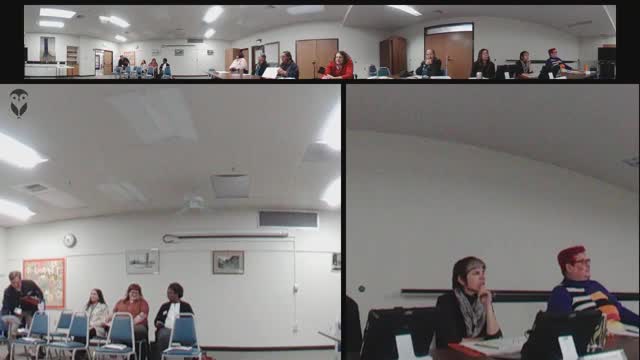Regional ombudsman describes advocacy role; commission hears volunteer expansion plans
February 09, 2025 | Davis, Yolo County, California
This article was created by AI summarizing key points discussed. AI makes mistakes, so for full details and context, please refer to the video of the full meeting. Please report any errors so we can fix them. Report an error »

The Davis Senior Citizens Commission heard a second presentation from the Agency on Aging Area 4 ombudsman team about resident advocacy, complaint investigation and volunteer programs serving long‑term care settings.
"It's a Scandinavian term meaning voice of the people," said Matt Grohloff, lead regional ombudsman, describing the ombudsman role as a resident‑centered advocate who identifies, investigates and works to resolve neglect, abuse and resident‑rights concerns in long‑term care. Grohloff said the federal Olmstead framework and state implementation require an ombudsman presence in the region and that his office covers multiple counties with a mix of regional staff and volunteers.
Grohloff told the commission the program's three primary functions are advocacy, education and empowerment — including training facility staff and first responders and conducting routine access visits to licensed skilled nursing and residential care facilities. He emphasized that ombudsmen are not mandated reporters and instead provide an advocacy pathway for residents who may be reluctant to make formal reports.
Commissioners and members of the public then heard from a staff member overseeing volunteers about current and planned volunteer efforts. The agency described several volunteer programs already active or under development: meal delivery drivers for Sutter and Yuba counties; garden build events at facilities; certified exercise instructors who lead regular classes; and a caring callers reassurance program in soft launch that matches volunteers by phone to isolated older adults on a recurring schedule.
The volunteer staffer said the agency had run six garden builds in the previous year and engaged about 300 volunteers across programs; the Meals on Wheels driver roster ranges roughly 75–100 deliveries per week in some areas. The caring callers pilot has received interest from older volunteers, college students and community members and is being matched in an initial rollout.
Grohloff and volunteer staff noted that volunteers help expand the program’s reach — for example, by supplementing mandated quarterly facility visits and by providing continuity for residents. Commissioners asked about facility ownership trends and care quality; Grohloff said larger corporate ownership sometimes brings cost‑cutting pressures that can affect staffing and quality, while smaller local providers often have stronger community ties.
Commissioners also raised questions about capacity determinations, involuntary discharges and resident rights. Grohloff said ombudsmen work with residents, families and facilities to assess whether residents can participate in decisions and to ensure appeal rights and safe discharge planning are followed. He offered to provide specific facility counts and bed totals to commissioners after the meeting.
The commission thanked ombudsman staff for materials and business cards and asked staff to share facility counts and other requested data.
"It's a Scandinavian term meaning voice of the people," said Matt Grohloff, lead regional ombudsman, describing the ombudsman role as a resident‑centered advocate who identifies, investigates and works to resolve neglect, abuse and resident‑rights concerns in long‑term care. Grohloff said the federal Olmstead framework and state implementation require an ombudsman presence in the region and that his office covers multiple counties with a mix of regional staff and volunteers.
Grohloff told the commission the program's three primary functions are advocacy, education and empowerment — including training facility staff and first responders and conducting routine access visits to licensed skilled nursing and residential care facilities. He emphasized that ombudsmen are not mandated reporters and instead provide an advocacy pathway for residents who may be reluctant to make formal reports.
Commissioners and members of the public then heard from a staff member overseeing volunteers about current and planned volunteer efforts. The agency described several volunteer programs already active or under development: meal delivery drivers for Sutter and Yuba counties; garden build events at facilities; certified exercise instructors who lead regular classes; and a caring callers reassurance program in soft launch that matches volunteers by phone to isolated older adults on a recurring schedule.
The volunteer staffer said the agency had run six garden builds in the previous year and engaged about 300 volunteers across programs; the Meals on Wheels driver roster ranges roughly 75–100 deliveries per week in some areas. The caring callers pilot has received interest from older volunteers, college students and community members and is being matched in an initial rollout.
Grohloff and volunteer staff noted that volunteers help expand the program’s reach — for example, by supplementing mandated quarterly facility visits and by providing continuity for residents. Commissioners asked about facility ownership trends and care quality; Grohloff said larger corporate ownership sometimes brings cost‑cutting pressures that can affect staffing and quality, while smaller local providers often have stronger community ties.
Commissioners also raised questions about capacity determinations, involuntary discharges and resident rights. Grohloff said ombudsmen work with residents, families and facilities to assess whether residents can participate in decisions and to ensure appeal rights and safe discharge planning are followed. He offered to provide specific facility counts and bed totals to commissioners after the meeting.
The commission thanked ombudsman staff for materials and business cards and asked staff to share facility counts and other requested data.
View full meeting
This article is based on a recent meeting—watch the full video and explore the complete transcript for deeper insights into the discussion.
View full meeting
